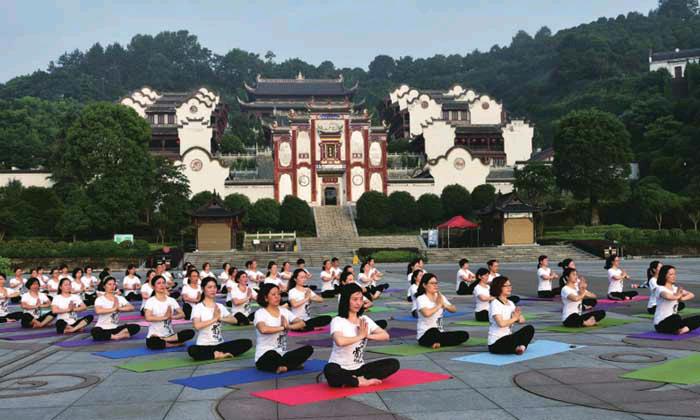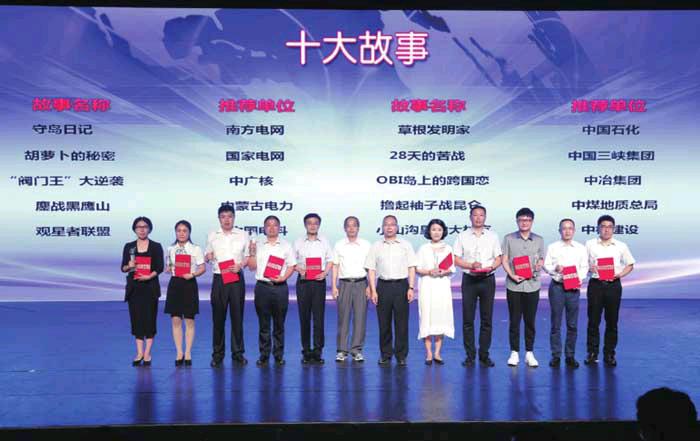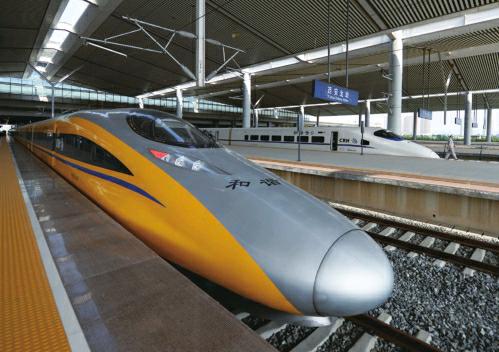Going to the Mat
Enthusiasts take part in a yoga session in Xuanen County, Hubei Province, on the eve of International Yoga Day, which was observed on June 21.
Ambitious Beijing
Beijing aims to become a top international city over the next fi ve years. Energy-intensi ve, heavily polluting industries will be phased out and the density of PM2.5 airborne particles will be reduced, according to the citys new development goals unveiled at the 12th Beijing Municipal Congress of the Communist Party of China (CPC), which started on June 19.
The city will improve the environment and promote green production and lifestyles, said Cai Qi, Secretary of the CPC Beijing Municipal Committee.
In a report, Cai listed the goals: taking the lead in building an allround prosperous society, making the 2022 Winter Olympics a great success, accelerating progress in the integrated development of the Beijing-Tianjin-Hebei region and improving the citys development.
Beijings average annual PM2.5 density fell 23.7 percent in 2016, compared to 2012 levels. Some 1,500 manufacturing and polluting companies have been closed in Beijing in recent years.
The city is striving to improve its function as the countrys political, cultural, international exchange and innovation center.
Waste Management
China plans to treat rural household waste in 90 percent of all villages by 2020, according to the Ministry of Housing and Urban-Rural Development (MOHURD).
MOHURD data show at the end of 2016, about 65 percent of villages across the country had begun collecting and treating household garbage, up 20 percentage points from 2014.
About 43 percent of that trash was sent to facilities in cities for treatment. Most provincial governments have set aside special funds to fi nance the program.
In China, waste management in rural areas lags behind that of urban areas, as trash is usually burned, buried, or discarded without treatment.
The MOHURD said it will improve waste collection and treatment as a priority and promote garbage sorting in the future.
Drug Crimes
China dealt with 541,000 drug crimes, sentencing 543,000 criminals from 2012 to 2016, said a white paper on June 20.
The report, issued by the Supreme Peoples Court (SPC), indicates that drug-related crimes are among the fastest growing offenses.
In 2012, drug crimes accounted for 7.73 percent of total criminal cases. But by 2016, the proportion had risen to 10.54 percent.
Ye Xiaoying, an SPC judge, said drug crimes were mainly prevalent in south, southwest, east and central China.
“China has handled more cases involving smuggling, producing and trading drugs, and dealt with cases of new types of drugs,” Ye said. “The SPC has always adhered to dealing with drug crimes severely in accordance with the law.”
From 2012 to 2016, a total of 119,000 criminals were sentenced to fi ve years or more in prison for drugrelated crimes, accounting for 21.91 percent of drug criminals.
Industrial Workforce
China will introduce reforms to strengthen its industrial workforce as part of a national strategy to become a manufacturing powerhouse.
According to a reform program released by the CPC Central Committee and the State Council on June 19, a more innovative and competitive workforce will be developed.
Industrial workers are a pillar for creating social wealth and innovation as well as building China into a world manufacturing power.
Reforms are needed to relax restrictions curbing the healthy development of the industrial workforce and to boost worker enthusiasm and innovation.
The program puts forward 25 reforms, including measures to sharpen workers skills, to strengthen the industrial workforce.
Transmission Record
Chinese scientists announced on June 19 they had realized the realtime transmission of deep-sea data for more than 190 straight days, a world record.
During an expedition to the West Pacifi c at the end of last year, researchers with the Institute of Oceanology under the Chinese Academy of Sciences realized realtime transmission of deep-sea data after improving a subsurface buoy observation network.
They put a f loating body on the sea, which was connected to a submersible buoy. The submersible buoy transmits data to the fl oating body, which then sends it to a satellite. Researchers then receive the data through the satellite, according to Wang Fan, Director of the institute, based in Qingdao, east Chinas Shandong Province.
The real-time deep-sea data include the condition of the submersible buoy and the fl owing speed, direction and pressure of seawater.
“Real-time transmission of deep-sea data provides important technical support for research on the ocean environment and global climate,” Wang said, adding that the data could enhance the precision of ocean climate and environment forecasts.
The previous world record for real-time transmission of deep-sea data was about 90 days, according to the institute.
Volunteer Teachers
China will dispatch 10,000 teachers to Xinjiang and Tibet autonomous regions to support local education.
Currently, 1,500 teachers from other provinces are in Xinjiang and Tibet. They train local education staff and share resources. Another batch of 4,000 teachers will be selected and sent to the regions soon, according to a meeting held in Urumqi, capital of Xinjiang, on June 15.
Recognizing the program as benefi cial to local people, Minister of Education Chen Baosheng de- manded strict standards in selection of teachers.
In recent years, the central and regional governments have worked hard to improve education in Xinjiang and Tibet.
Bilingual education has made remarkable progress. In Xinjiang, 78 percent of students in primary and middle schools receive bilingual education.
TCM Development
Traditional Chinese medicine (TCM) will be given a bigger role in prevention and treatment of major diseases, according to a plan by the Ministry of Science and Technology and the State Administration of Traditional Chinese Medicine.
The plan lays out major tasks including developing technology and new TCM products and applications.
According to a 2016 white paper on TCM, 45 items of TCM research have won national science and technology awards, with fi ve taking the top prize.
TCM is an important health and economic resource with huge potential. However, domestic TCM development faces signifi cant challenges particularly in standards and quality control.
The plan stresses that, by 2020, problems hindering TCM expansion should be solved and at least 50 pharmacopeial standards as well as 100 industry standards should be established.
China should also complete the registration of fi ve to 10 medications with TCM ingredients in developed countries, the plan said.
Masterstroke!
A visitor looks at a painting during the media preview of an exhibition, Rembrandt and His Time: Masterpieces From the Leiden Collection, at the National Museum of China in Beijing on June 16. A total of 70 paintings, including 11 by Rembrandt, will be on display from June 17 to September 3.
Senior Care
The State Council has issued a guideline to better serve the countrys senior citizens.
The document, released on June 16, includes 20 key tasks concerning the increasing elderly population, such as establishing an electronic database of their health conditions, providing a pension for poor or disabled seniors, increasing access to educational resources, and setting up a long-term care insurance system.
The Ministry of Civil Affairs said more than 220 million Chinese citizens were over the age of 60 at the end of 2016. The government has predicted that the elderly will account for about one quarter of the population by 2030.
The State Council issued a plan in March for state-owned nursing homes to account for at least 30 percent of the nations total residential care facilities for the elderly by 2020.
Bringing Ancient Technology Back to Life
Visitors learn movable-type printing at a workshop in Qingdao, Shandong Province, on June 21. Movable-type printing, one of the worlds oldest printing techniques, was fi rst invented in China.
Excellent Performance for Big Dreams
Ten representatives from centrally administered state-owned enterprises receive awards for the dedicated and innovative spirit of front-line staff on June 21.
Rising Innovative Ranking
China has moved up the list of the worlds top 25 innovative economies, rising three notches from 25 to 22, with strong performance in several indicators, according to the latest Global Innovation Index (GII).
Chinas technological innovations have made headlines in recent months, from the launch of its fi rst X-ray space telescope to observe black holes and development of the worlds fi rst quantum computing machine, to the debut of its homegrown C919 passenger jet and its successful sampling of combustible ice.
Jointly released by the World Intellectual Property Organization, Cornell University, and INSEAD, the 2017 GII is in its 10th edition this year. The rankings are a leading bench- marking tool for business executives, policymakers and others seeking insight into the state of innovation around the world.
A closer look into the general index shows that China moved up one spot to 16th in innovation quality, retaining its position for the fi fth consecutive year as the top middleincome economy and edging closer to high-income economies.
The report showed that China topped in a number of sub-rankings, including domestic market scale, human resources, patents by origin, hi-tech exports, and industrial designs by origin.
Chinas qualifi ed patents exceeded 1 million last year, becoming the third country after the United States and Japan to join the worlds million patents club.
Meanwhile, the number of“unicorn” companies in China—young, unlisted companies with a market value of over $1 billion—rose from 70 in 2015 to 131 in 2016, most of which are hi-tech fi rms, according to the Ministry of Science and Technology.
Innovation is at the core of the countrys 13th Five-Year Plan (2016-20). According to the plan, China aims to become an innovative nation by 2020, an international leader in innovation by 2030, and a world powerhouse of scientifi c and technological innovation by 2050.
Cooling Home Prices
Chinas home prices have shown signs of cooling as prices faltered in major cities after authorities implemented a string of measures to contain price hikes.
Of the 70 large and medium-sized cities surveyed, 35 cities witnessed a month-on-month price decline or a slower price uptick in May, up from 31 in April, said the National Bureau of Statistics (NBS) on June 19.
A total of 29 cities witnessed a slower year-on-year price rise in May, said the NBS.
All of the 15 fi rst- and secondtier cities surveyed saw slower yearon-year price rises in May, and nine of them also saw month-on-month price declines or fl at prices.
New residential house prices in Shenzhen, a southern metropolis neighboring Hong Kong, fell 0.6 percent month on month in May, while house prices in Beijing and Shanghai remained fl at in May from April.
“Prices of newly built homes in 15 major cities including Beijing, Shanghai and Shenzhen continued to stabilize in May on the back of targeted local government policies,”said NBS statistician Liu Jianwei.
Since October of last year, local governments have implemented a slew of measures to rein in rising home prices and quash potential asset bubbles.
Given the tougher measures, analysts predict that home prices will continue to cool in coming months, and there will be more intensifi ed policies due to price rises in some third-tier cities.
Online Shopping Spree
Chinese consumers online shopping potential is growing. Apart from November 11, or Singles Day, the countrys biggest shopping day, they are unleashing their spending power during a mid-year online shopping spree.
E-commerce giant JD Inc. reported its sales during the mid-year online shopping festival reached 119.9 billion yuan ($17.6 billion). Other e-commerce heavyweights also jumped on the bandwagon to offer special deals and attract more consumers.
During the “6.18” anniversary sales event between June 1 and 20,which was launched by JD.com to mark its establishment, the fi rm said more than 700 million items were sold. The transaction volume increased more than 50 percent compared to the same period last year.
It is noteworthy that the number of female consumers is continuously on the rise. During this years event, the number of female fi rst-time customers on JD.com was nearly double the number during last years event.
New AIIB Members
The Asian Infrastructure Investment Bank (AIIB) on June 16 approved the membership of Argentina, the Republic of Madagascar and the Kingdom of Tonga at the second annual meeting of its board of governors, held in South Koreas southern resort island of Jeju.
The three prospective members will offi cially join the AIIB once they complete the required domestic processes and deposit the fi rst installment of capital with the bank.
Interest in the AIIB remains high and the banks door remains open to new members, said Danny Alexander, Vice President and Corporate Secretary of the AIIB.
The international infrastructure bank owns about $100 billion of subscribed capital, including some$20 billion in paid-in capital.
The meeting in Jeju brought together about 2,000 participants, including delegations of members, international organizations and academia as well as business people, fi nanciers and journalists.
Ready to Go
A high-speed train waits at Xian North Railway Station in Xian, capital of northwest Chinas Shaanxi Province, for a test run of the Xian-Chengdu Passenger Railway on June 20. The railway is the fi rst high-speed railway to travel through the Qinling Mountains.
Easing Investment Restrictions
The Chinese Government on June 16 published an updated list of bans or restrictions for foreign investment in its free trade zones, cutting 27 restrictions across eight sectors including mining, manufacturing and banking. In manufacturing, foreign companies are allowed to produce their own rail transport facilities, instead of having to set up joint ventures with local fi rms. Rules were also eased for foreign companies manufacturing electric vehicles and related products.
In fi nance, foreign banks are permitted to underwrite government bonds and they do not have to wait for a minimum period of operation to launch RMB services.
The list, fi rst compiled in 2013, spells out specifi c bans or restrictions on foreign investment. Authorities have vowed to gradually shorten the list to further open Chinas markets.
In 2013, there were 190 items on the list. The list now stands at 95 items.
Fruitful Fair
Visitors look at vegetables and fruit at the 15th China Cross-Straits Technology and Projects Fair in Fuzhou, capital of southeast Chinas Fujian Province, on June 18. More than 2,000 companies from both the Chinese mainland and Taiwan took part in the exhibition to showcase their latest technological achievements.
FDI and ODI in May
Foreign direct investment (FDI) on the Chinese mainland dropped 3.7 percent year on year in May to 54.67 billion yuan (about $8.05 billion), extending a downward trend, data from the Ministry of Commerce(MOFCOM) showed on June 15.
The decline followed a mild retreat in the previous month, when FDI was 4.3 percent lower than last April, in contrast with a 6.7-percent increase in March.
Despite a drop in the overall FDI, foreign investment in the service sector, especially hi-tech and modern service industries, continued steady growth.
Offi cial data showed on June 16 that Chinas non-fi nancial outbound direct investment (ODI) dropped 38.8 percent year on year to $8.22 billion in May.
In the fi rst fi ve months of this year, the countrys non-fi nancial ODI dropped 53 percent year on year to $34.59 billion, according to MOFCOM.
Chinese companies invested in 3,121 overseas enterprises in 145 countries and regions from January to May.
Outbound investment to countries involved in the Belt and Road Initiative accounted for 14.4 percent of the total ODI in the fi rst fi ve months, up 6.7 percentage points from the same period last year.

